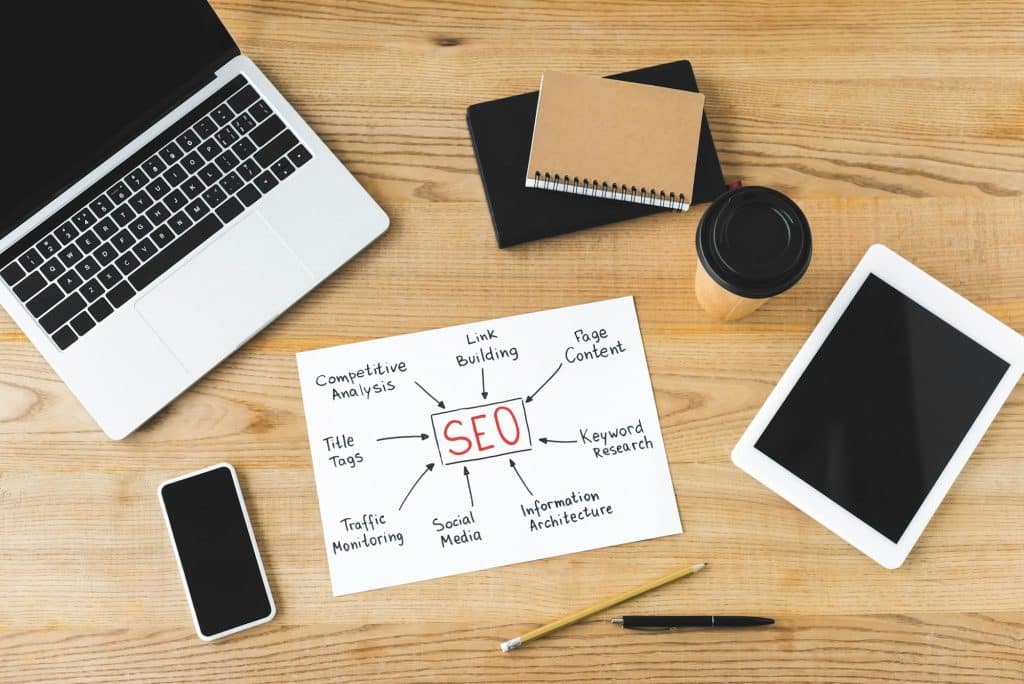SEO for ecommerce shop in 2024 (comprehensive guide)

Category:SEO
Publish Date: 2024-03-20 13:20:40
In the digital bazaar, where the clamor and clang of commerce never ceases, the artistry of search engine optimization (SEO) for ecommerce websites emerges as the linchpin in the relentless pursuit of visibility and conversion. As the digital landscape burgeons, SEO transcends mere technicality, evolving into an intricate tapestry woven with the threads of human insight, technical acumen, and strategic foresight. The quintessence of SEO strategy for ecommerce website realm is not merely about attracting eyes but about captivating minds, guiding them through the labyrinthine alleys of the internet to the doorstep of your digital emporium.
So, embarking on a journey to elevate your online presence? You’ve arrived at the right destination. Let us navigate the complex world of search engine optimization together, transforming challenges into opportunities and clicks into customers. Discover the difference a tailored SEO strategy can make for your business today.
If you wish, you can use the SEO services of our team. For more information, visit SEO in Vancouver.
This table serves as a high-level overview of each SEO strategy, highlighting the benefits and potential challenges you might face. Keep in mind that successful SEO requires a balanced approach, integrating these strategies cohesively rather than relying on a single tactic. Each strategy’s effectiveness can vary based on your specific ecommerce niche, audience, and competitive landscape.
We suggest you also read this article:






Illustrative SEO Strategy for Ecommerce Website Guide
Here’s an illustrative table summarizing the SEO strategies we will discussed, along with their benefits, boundaries, and additional considerations:| SEO Strategy | Benefits | Boundaries | Considerations |
| Keyword Research | Drives targeted traffic, Enhances content relevance | Time-consuming, Competitive keywords can be hard to rank | Use a mix of tools for comprehensive research |
| Site Architecture | Improves site navigation, Enhances SEO | Requires technical knowledge, Can be complex to implement in large sites | Plan architecture early in site development |
| On-Page SEO | Increases page visibility, Improves user engagement | Requires continuous optimization, Balancing keyword use without stuffing | Focus on quality content and meta optimization |
| Technical SEO | Enhances site speed and security, Improves crawlability | Technical expertise required, Constant monitoring and updates needed | Prioritize mobile optimization and site speed |
| Content Marketing | Builds brand authority, Engages and retains audience | Resource-intensive, Requires strategic planning | Diversify content types (blogs, videos, infographics) |
| Link Building | Increases site authority, Drives referral traffic | Risk of penalization for spammy practices, Time-consuming | Focus on quality over quantity of links |
| User Experience (UX) | Improves satisfaction and conversion rates, Lowers bounce rates | Requires continuous testing and updates, User expectations can vary widely | Implement responsive design, Optimize for usability |
| Voice Search Optimization | Captures growing voice search market, Enhances accessibility | Still evolving, Harder to predict exact query phrases | Focus on natural language and question-based content |
| Image SEO | Improves image search visibility, Enhances page load speed | Requires consistent alt tags and file optimization, Large images can slow down site | Optimize alt attributes, Compress images |
| Local SEO for Physical Stores | Drives local traffic, Increases in-store visits | Limited to geographical area, Requires accurate NAP consistency | Claim and optimize Google My Business listing |

Keyword Research is The Keystone of SEO Strategy for Ecommerce Website
At the heart of a successful SEO strategy lies the cornerstone of keyword research, a meticulous and sagacious endeavor that bridges the chasm between obscurity and prominence. The alchemy of transforming generic terms into golden queries that lead seekers to your digital domain is both an art and a science.- Wikipedia as an Unlikely Ally
- SEMrush
- Google Keyword Planner
The Four-Pronged Approach to Keyword Selection in SEO for Ecommerce Shop
The selection of keywords is not a mere act of accumulation but a deliberate choice guided by a four-pronged approach:- Search Volume: The beacon that signals the presence of an audience, indicating the words they use to whisper their needs into the void of the search engine.
- Keyword-Product Fit: A measure of alignment, ensuring that the chosen keywords resonate with the essence of what you offer, ensuring that the seekers find not just any answer, but your answer.
- Competition: The assessment of the battlefield, understanding the strength of those who currently hold sway over your desired keywords.
- Intent: The deciphering of the searcher’s underlying motive, distinguishing between those who seek knowledge and those poised to take action.

Site Architecture for SEO Ecommerce Store
In the grand edifice of ecommerce SEO, if keyword research lays the foundation, then site architecture constitutes the intricate blueprint that guides the construction of a digital fortress designed to stand the test of time and algorithmic shifts. The architecture of your ecommerce site is the skeletal framework upon which the flesh of content, the heart of user experience, and the mind of SEO strategy coalesce into a living, thriving entity. At the core of effective site architecture lies the philosophy of simplicity and intuition. A well-structured ecommerce site mirrors the elegance of a well-orchestrated symphony, where every section, every category, and every product finds its place in a harmonious order that resonates with the user’s innermost expectations. This harmonious structure not only facilitates the seamless navigation of human visitors but also allows the search engine spiders to crawl and index the site with unerring precision. Navigational Elegance: The paramount importance of a logical, hierarchical navigation cannot be overstated. It is the compass that guides the user through the myriad offerings of your ecommerce site, ensuring that their journey from the landing page to the checkout is as intuitive as the turning of pages in a well-loved book. This navigational elegance is achieved through a minimalist approach, eschewing the clutter of overabundance for the clarity of well-defined paths. URL Structure: The URL structure of your ecommerce site is the lexicon of its navigation, with each URL serving as a distinct word that communicates specific information about the page it represents. URLs should be crafted with a clarity that speaks directly to both users and search engines, embedding within them the keywords that echo the user’s search queries. A clean, descriptive URL structure is not just an SEO tactic but a beacon of clarity in the digital fog, guiding users effortlessly to their desired destination. Breadcrumbs: Breadcrumbs, often overlooked in their simplicity, play a crucial role in the site architecture. They offer users a way to trace their journey back to their starting point or to leap across related categories with ease. For search engines, breadcrumbs provide a clear structure of the site hierarchy, enhancing the indexing process. They are the subtle threads that weave together the user experience and SEO, ensuring that neither is lost in the depths of the site.
On-Page SEO Strategy for Ecommerce Website
In the realm of ecommerce SEO, mastering the art of on-page optimization is akin to the ancient pursuit of alchemy. It is here that the base metals of raw content are transmuted into the gold of highly ranked web pages, through a blend of creativity, strategy, and technical prowess.- The Genesis of Title Tags
- Meta Descriptions
- Header Tags
- The Lure of LSI Keywords
- Internal Linking
XML Sitemaps and Robots.txt
In the depths of technical SEO, XML sitemaps serve as the map of the underworld, guiding the search engines through the myriad pages of your site, ensuring no treasure remains hidden in the shadows. The Robots.txt file, in contrast, is the strategy to navigate this map, instructing search engines on the paths to follow and the vaults to bypass, optimizing the crawl budget to focus on the pages that truly matter.
Content Marketing in SEO for Ecommerce Shop
In the grand tapestry of ecommerce SEO, content marketing emerges as the vibrant threads that add depth and color to the narrative of your brand. It’s not merely about populating your site with words and images; it’s an art form that weaves together the stories of your products with the needs and desires of your audience. This chapter embarks on a journey through the realm of content marketing, exploring how to craft compelling narratives that elevate your brand and enchant your audience.- The Storytelling and Crafting Compelling Narratives
- The Alchemy of Blogging
- The Visual Odyssey
- The Symphony of social media

The Enchantment of Link Building
In the mystical journey of ecommerce SEO, link building acts as the spellbinding process of weaving a web of connections across the digital realm. This intricate web, spun with threads of credibility and authority, serves to elevate your site in the eyes of the search engines, a testament to its worthiness and relevance.Identifying Link Opportunities in SEO Strategy for Ecommerce Website
The quest begins in the gathering of allies, identifying those websites, blogs, and forums where your brand’s presence would be both relevant and welcomed. This reconnaissance involves delving into the communities your audience frequents, understanding the content they consume, and identifying the gaps your knowledge can fill. Whether it’s guest blogging, participating in forums, or contributing to industry publications, each connection forged is a thread added to your web, strengthening your SEO foundation.The Art of Crafting Valuable Content
In the heart of the forest, where the competition is fierce, the creation of valuable, share-worthy content stands as your most potent weapon. This is content that illuminates, educates, and entertains, crafted with the intent of not just serving your audience but enchanting them. Such content naturally attracts links, as others in your realm seek to share your wisdom, your innovations, and your stories with their own followers, thereby weaving your threads into the fabric of the digital tapestry.Analytics in SEO Strategy for Ecommerce Website
Beyond the visible horizon of ecommerce SEO lies the mystical realm of analytics, a domain where the runes of data hold the secrets to understanding and optimizing your digital strategies. This is the alchemy of analytics, where raw data is transformed into insights, guiding your path through the ever-changing landscape of the digital marketplace. In the pursuit of wisdom, certain metrics emerge as the Holy Grails, each a beacon illuminating aspects of your SEO and content marketing strategies. Traffic volume, bounce rates, conversion rates, and keyword rankings stand as the cardinal points, guiding your analysis. By deciphering these runes, you can unearth the strengths and weaknesses of your tactics, adjusting your course to better align with the desires of your audience and the demands of the search engines. Among the tools at your disposal, Google Analytics serves as the oracle, offering a gaze into the abyss where insights swim in the deep. Here, you can track the journey of your visitors, from their first tentative clicks to the final act of conversion. This tool allows you to see not just the paths they tread but also the places where they falter, providing the knowledge needed to smooth their way and enhance their journey.The Art of Conversion Rate Optimization
Armed with insights, the art of conversion rate optimization becomes your focus, a process of fine-tuning the machine to ensure that traffic not only flows but also fulfills its intended purpose. This involves experimenting with different elements of your site, from the layout of product pages to the wording of call-to-action buttons, each tweak a step towards turning visitors into customers. The alchemy of analytics is not a one-time spell but a continuum of learning, a cycle of insights and action that evolves with your site and your audience. It demands curiosity, adaptability, and a willingness to delve into the numbers, seeking the story they tell. Master this art, and you unlock the potential not just to react to the present but to anticipate the future, guiding your ecommerce site to ever-greater heights of success.
Advanced SEO Strategy for Ecommerce Website Tips
In the grand saga of ecommerce SEO, we stand at the threshold of the arcane, delving into advanced strategies that blend the mystical with the practical. This chapter unveils the secrets of optimizing for voice search, enhancing image SEO, and leveraging local SEO for physical stores, alongside the pivotal role of user experience (UX) in the alchemy of search rankings.- Optimizing for Voice Search
- Enhancing Image SEO
- Using Local SEO for Physical Stores
- The Significance of User Experience (UX)
Last to Say
As we close the tome on this chapter of our ecommerce SEO odyssey, it’s clear that the journey is far from over. The landscape of digital commerce is ever-changing, with new challenges and opportunities arising with the passage of time. Yet, armed with the knowledge of both foundational and advanced SEO strategies, you are now better equipped to navigate this realm. Remember, the key to mastery lies not in the application of individual tactics but in weaving them together into a cohesive strategy that elevates your brand, enchants your audience, and secures your place in the pantheon of ecommerce success. The journey continues, and with each step, you write your own legend. As we wrap up this insightful exploration into the realms of SEO, remember that the pathway to digital excellence is ever-evolving. With Ramikar Agency by your side, you’re not just adapting to the landscape; you’re setting the pace. From Vancouver to the vast expanse of Canada, our comprehensive SEO services are designed to put your brand on the map and keep it there. Ready to dominate your niche and outshine the competition? Reach out to Ramikar Agency, where your business’s potential becomes our mission. Let’s embark on this journey to the pinnacle of digital success together. [elementor-template id=”19628″] FAQs What is the importance of SEO for ecommerce websites? SEO is crucial for ecommerce websites as it enhances visibility in search engines, drives organic traffic, and improves user experience, leading to higher conversion rates and sales. It ensures your products and services are found by potential customers at the moment they’re searching for them online. How can I perform effective keyword research for my ecommerce site? Effective keyword research involves using tools like SEMrush and Google Keyword Planner to find high-volume, relevant keywords that match your product offerings. Consider using Wikipedia for category and product page ideas, and focus on a mix of short-tail and long-tail keywords to capture a wide range of search intents. What are some advanced SEO strategies for ecommerce sites? Advanced SEO strategies include optimizing your site for voice search by targeting question-based queries, enhancing image SEO through alt tags and file naming conventions, and leveraging local SEO for physical stores to improve visibility in local search results. Additionally, focusing on creating a superior user experience (UX) can indirectly boost your SEO rankings. How does user experience (UX) impact SEO for ecommerce sites? User experience (UX) directly impacts SEO by influencing factors like site dwell time, bounce rate, and click-through rates, which are indicators of a site’s value to users. Search engines favor sites that provide a positive user experience, making UX a critical component of your SEO strategy. Can blogging enhance SEO for my ecommerce website? Yes, blogging can significantly enhance SEO for ecommerce websites by providing fresh, relevant content that can rank for a wide range of keywords. It helps establish your site as an authority in your niche, drives organic traffic, and offers opportunities for internal linking, which strengthens your site’s SEO. What role do internal links play in ecommerce SEO? Internal links help distribute page authority throughout your site, making it easier for search engines to crawl and index your content. They also improve site navigation for users, leading to a better user experience and potentially higher conversion rates. Strategically placing internal links in your content can boost the SEO performance of individual pages. How can I optimize my ecommerce site for mobile users? Optimize your ecommerce site for mobile users by ensuring it has a responsive design that adjusts content layout based on device size, improving site speed for faster mobile loading times, and simplifying navigation to enhance the mobile shopping experience. Mobile optimization is essential for SEO, as search engines prioritize mobile-friendly sites in their rankings.Recent Articles:

Video Marketing Canada: Best Strategies for 2025
7 months ago
5 min 25 sec read

Photography Services Canada: For Web & Social Media Use
8 months ago
5 min 2 sec read

Logo Design Canada: Create a Logo That Truly Stands Out
8 months ago
4 min 38 sec read
Let us help !
Related Posts
Comments
0
0
votes
Article Rating
Subscribe
Login
0 Comments
Oldest
Newest
Most Voted
Inline Feedbacks
View all comments






